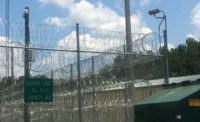Like many of Northeastern Pennsylvania’s small cities, economic revitalization has been a driving factor in the rebirth of the region over the past decade. For the city of Wilkes-Barre, located in the heart of Luzerne County and just hours from major cities like New York, Philadelphia, and the resorts of the Pocono Mountains, ensuring that visitors and its 43,000 residents perceive Wilkes-Barre as a vibrant and safe community was a primary objective for city officials.
In tandem with a string of economic development projects designed to make Wilkes-Barre an attractive destination for business and tourism, such as a new $28 million Intermodal Transportation Center and a $7.7 million project to enhance the downtown streetscape, local leaders also realized the importance of investing in technology to improve security in downtown Wilkes-Barre and throughout the city’s neighborhoods.
Thanks to a multi-million dollar investment in a wireless surveillance camera network that will monitor the city’s downtown and other high-risk areas, Wilkes-Barre is at the forefront of crime deterrence via surveillance camera security monitoring. When complete, the security initiative calls for more than 300 surveillance cameras to be operational within city limits, making it one of the largest per capita camera deployments in the United States.
Like most urban centers using video for municipal surveillance, Wilkes-Barre wanted both to deter crime and provide law enforcement with useable video for investigations and criminal prosecutions. Key to the project’s success, however, was the realization that not only would the camera network serve as a valuable tool for police, but could also prove to be a boon to local economic development efforts.
“Small communities throughout the country are increasingly experiencing big city problems with crime and drugs,” said J.J. Murphy, former Wilkes-Barre city administrator. “We didn’t want to react to this trend five years down the line, but instead be proactive and implement a progressive initiative to deter crime and contribute to our city’s quality of life.”
To facilitate the camera deployment, in 2007 city officials began the Safe City Initiative, building a city-wide wireless infrastructure that would enable cameras to monitor several different areas of the city, such as the downtown area and Public Square, city parks, and eventually schools, parking lots and garages. To manage the project, a non-profit organization, Hawkeye Security Solutions, was formed to run the camera project and operate the state of the art command center where the city’s cameras are monitored.
In conjunction, city officials launched a national Request for Proposal process to search for the right mix of technology and integration vendors to deploy the extensive network. After sorting through proposals from 13 different vendors, the city and Hawkeye Security selected a camera and video management software solution from DVTel Inc. (www.dvtel.com). Schneider Electric (www.schneider-electric.com) was selected to design and build the surveillance network.
“At Schneider Electric we leveraged our system design expertise for Wilkes-Barre, ensuring seamless connection and integration for the DVTel IP cameras and iSOC platform,” said Sam Belbina, vice president of systems integration East for Schneider Electric. “This project has proved unique given the number of cameras deployed throughout the city and the wireless network that serves as its backbone.”
Housed at Wilkes-Barre police headquarters, the command center monitors the DVTel Altitude PTZ dome and fixed IP cameras, all capable of producing dual-stream H.264/MPEG-4 video as well as featuring bi-directional audio for capturing complete details of a scene. The cameras are managed with DVTel’s intelligent Security Operations Center (iSOC) platform, which creates a common operational picture that enables security personnel to capture, manage, analyze, integrate, and then act on previously unorganized and overly complex data. The results are improved reaction time, enhancing operator productivity and a reduction in incidents.
“We chose the solution that was the most advanced and the best fit for our needs,” Murphy said. “The city is thrilled with what the system has enabled us to accomplish.”
More than 150 DVTel cameras are already operational throughout the city, mounted on city-owned streetlights in 19 neighborhood parks and downtown Wilkes-Barre. By October, an additional 150 cameras are expected to be live on the network, 70 of which will be monitoring the city’s high school and middle schools through a partnership with the Wilkes-Barre Area School district. The remainder of the cameras will be deployed in other areas of the city and, in conjunction with the city’s Parking Authority, at parking garages and parking lots throughout Wilkes-Barre.
Finding the resources to deploy the surveillance network outside of city funds was essential to the project, city officials said. By proving that the cameras would provide a substantial economic benefit to the city as well as to the surrounding area, the $2.8 million Safe City Initiative has been funded from federal and state grant money, including federal stimulus funding from the American Recovery and Reinvestment Act of 2009, and funds from the Pennsylvania State Gaming and Pennsylvania Community and Economic Development Departments. Businesses in downtown pay a fee to belong to the city’s Business Improvement District, part of which has helped to install a higher density of cameras in that area and ensure around-the-clock monitoring.
In the first few months of camera deployment, city police have already requested video to use in six incidents, with more than a dozen events, such as car accidents and minor public disturbances, already caught on video. Video is monitored in real-time at the command center, where DVTel’s Latitude Network Video Management System manages the various camera feeds and displays available images on a wall of 10 monitors.
“I expect the cameras to be a great deterrent to criminal activity in the areas where they are deployed,” said Wilkes-Barre Police Chief Gerard Dessoye. “They have already proven to be a valuable tool in assisting our investigations, allowing the officers to provide a higher level of protection to the community.”
Local officials also expect that the camera network will be invaluable during large events in the city, and periods of time when crime is typically high. Information captured from the cameras can be relayed to emergency dispatchers at the regional 911-dispatch center. — Contributed by Paul Smith, chief operating officer, DVTel Inc.
| PROJECTS in the News |
|
Vicon Industries Inc., working with Advanced Automation Systems Inc. of Tampa Fla., found a novel and valuable application for its pressurized, high-performance SurveyorVFT pan-tilt-zoom camera dome. It is being used as a “beach cam” in Sarasota, Fla., where its live, 24/7 online video feed is helping to reassure potential tourists that the county’s beaches have not been tarnished by this summer’s oil spill. The camera slowly pans the entire expanse of beach, clearly displaying a 180-deg. view. Live video from the Beach Cam is online at http://www.scgov.tv/siestabeachcam. The camera receives an average of 5,000 hits per week. *** Acker-Stone Industries, a Corona, Calif., manufacturer, is monitoring its corporate office and manufacturing facility using DVTel’s (www.dvtel.com) intelligent video analytics from ioimage to detect security breaches and quickly identify safety issues for employees. The intelligent video solution is remotely viewed by Virtual Guard Inc. (www.virtualwatchguard.com), a remote video monitoring company in Chatsworth, Calif. By pairing intelligent video with the company’s remote monitoring capabilities, Virtual Guard is able to prevent theft, identify security breaches and provide enhanced security for employees. *** There has been a high volume of criminal activity around the perimeter of developments and in elevators operated by New York City (NYC) Municipalities. It has not been easy in the New York area, explained David Gonzalez, director of business development for Tri-Ed / Northern Video Distribution. “Low to no lighting around the perimeters makes them prime targets for criminals at night,” Gonzalez said. “NYC Agencies & Authorities have been concerned with security issues in elevator cabs as well, since cameras were easily and quickly vandalized in such environments. The NYC Agencies & Authorities were looking to install a cutting-edge surveillance system that would operate well under poor lighting conditions and in vandal prone areas to help them successfully prosecute criminal offenders.” Gonzalez discovered that the Bosch WZ20 Bullet Cameras reliably captured high-quality images suitable for prosecution under poor lighting conditions, delivering 150 ft. of high-performance night vision in 0 lux environments. The Bosch Extreme series Corner-mount No-grip Cameras were highly resistant to vandalism due to steel construction. “The Agencies & Authorities are now able to work with police departments and district attorneys to successfully prosecute criminal activities at their buildings and developments.” *** CodyHigh School in Wyoming worked with integrator ISC Corporation to replace its analog video system with Axis Communications (www.axis.com) network cameras to improve the protection of students, secure community events and future-proof school security. The video captured by the school’s decade-old analog video cameras yielded too few details to be useful.
“The video from our old analog camera system was so pixilated, we only identified culprits about 15 percent of time,” said Brandon Jensen, principal of Cody High School. “Our new Axis cameras have such amazing image clarity that so far we’ve been able to identify who was doing what 100 percent of the time.” ***
The Greenbrier resort in White Sulphur Springs, W.Va., deployed a Pelco (www.pelco.com) IP-based video surveillance system in its new Casino Club gaming facility. Designed and built by North American Video (NAV) and M. Malia and Associates (MMA), the video surveillance system features approximately 400 cameras installed in a building designated as a National Historic Landmark. The IP cameras, a mixture of megapixel and high resolution imaging technologies, are integrated with a powerful recording structure to ensure all available storage is symmetrically utilized. ***
The Centrum Properties Roosevelt Collection project, a luxury urban residential, retail, entertainment complex in Chicago’s South Loop district, required an integrated system solution to send high quality video over long distances over structured cable. According to Richard Superfine, president of M&R Electronic Systems, Altronix’s HubWay UTP Transceivers (www.altronix.com), which transmit high quality video up to a mile with several units that also provide camera power, were the perfect fit for the application. *** In order to boost community safety and reduce criminal activity, the city of Selma, Ala. deployed the Avigilon (www.avigilon.com) High Definition (HD) Surveillance System. Positioned at the Selma Police Department (SPD) and at the Selma Housing Authority’s George Washington Carver (GWC) complex, a 215-apartment facility with more than 500 tenants, the system has helped reduce criminal activity by 75 percent.
The city of Selma has installed more than 30 HD cameras ranging from three to five megapixels to monitor the exterior of the GWC complex and at police headquarters. The SPD installed several Avigilon Analog Video Encoders to create a hybrid surveillance system that improves the performance of its existing analog cameras. The city has also installed an Avigilon HD camera to monitor the Mayor’s Office at City Hall. Storing up to 45 days of continuous surveillance video, the Avigilon HD Surveillance System is monitored around-the-clock at both the SPD and GWC complex. |





